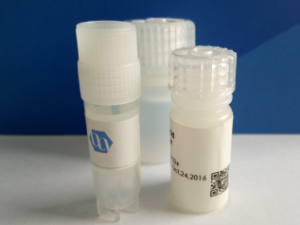$ 1,250.0
Quantity: 50 MG
Available on backorder
Description
Product name: Azemiopsin
Catalog#: 1809070
Synonyms:
CAS NO.:
Sequence: DNWWPKPPHQGPRPPRPRPKP
M.W: 2540.89
M.F.: C118H174N38O26
Purity: 95% by HPLC
Counter ion: Trifluoacetate
Format: Lyophilized powder
Description: Azemiopsin, a novel polypeptide, was isolated from the Azemiops feae viper venom by combination of gel filtration and reverse-phase HPLC. Its amino acid sequence (DNWWPKPPHQGPRPPRPRPKP) was determined by means of Edman degradation and mass spectrometry. It consists of 21 residues and, unlike similar venom isolates, does not contain cysteine residues. According to circular dichroism measurements, this peptide adopts a β-structure. Peptide synthesis was used to verify the determined sequence and to prepare peptide in sufficient amounts to study its biological activity. Azemiopsin efficiently competed with α-bungarotoxin for binding to Torpedo nicotinic acetylcholine receptor (nAChR) (IC50 0.18 ± 0.03 μm) and with lower efficiency to human α7 nAChR (IC50 22 ± 2 μm). It dose-dependently blocked acetylcholine-induced currents in Xenopus oocytes heterologously expressing human muscle-type nAChR and was more potent against the adult form (α1β1ϵδ) than the fetal form (α1β1γδ), EC50 being 0.44 ± 0.1 μm and 1.56 ± 0.37 μm, respectively. The peptide had no effect on GABAA (α1β3γ2 or α2β3γ2) receptors at a concentration up to 100 μm or on 5-HT3 receptors at a concentration up to 10 μm. Ala scanning showed that amino acid residues at positions 3–6, 8–11, and 13–14 are essential for binding to Torpedo nAChR. In biological activity azemiopsin resembles waglerin, a disulfide-containing peptide from the Tropidechis wagleri venom, shares with it a homologous C-terminal hexapeptide, but is the first natural toxin that blocks nAChRs and does not possess disulfide bridges.
Compound ID:
Usage: For Scientific Research Use Only, Not for Human Use.
Reference:
J Biol Chem. 2012 Aug 3; 287(32): 27079–27086.

